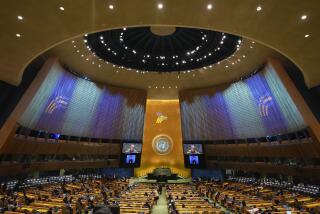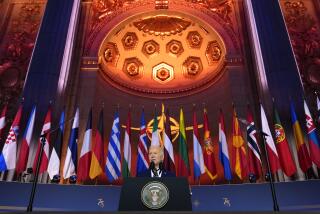U.S., Soviets Achieve Arms, Trade Accords : Summit: One treaty slashes chemical weapons stockpiles. Others pledge a nuclear pact by yearâs end and an open path to commerce.
WASHINGTON â President Bush and Soviet President Mikhail S. Gorbachev, seeking Friday to write the final chapter of the 45-year Cold War, signed a treaty slashing their nationsâ stockpiles of deadly chemical weapons and reached agreement in principle on a treaty making deep cuts in their awesome nuclear weaponry.
They also signed a treaty that could eventually lead to greater trade between the two superpowers, but only if the Soviets guarantee their citizens the right to emigrate. Moreover, members of Congress said they would block trade concessions to the Soviets until Moscow relaxes economic sanctions again Lithuania.
Gorbachev had devoutly sought a trade accord to demonstrate his determination to shore up the sputtering Soviet economy.
But to the United States, the dayâs prize was the nuclear arms agreement. The document commits the superpowers to complete by the end of the year a so-called START treaty that would cut their arsenals of strategic nuclear weapons by about one-third to one-half.
In addition to the big-ticket items, the leaders also reached 13 other accords, including one extending politically sensitive U.S. grain sales to the Soviet Union.
âThe agreements we record today and those yet to come will advance the cause of peace, agreements in the best interests of both our nations, and all nations,â Bush said before sitting down at a heavy wooden table in the White House East Room to sign the historic documents.
Gorbachev told Bush that the documents they and their aides were about to sign represented âan event of momentous importance, not only for our two countries but for the world.â
The solemn ceremony, capping the second day of Gorbachevâs four-day state visit, provided a formal flourish for the sharp improvement in East-West relations during the past year.
Today, their formal talks complete, the two presidents and their wives will travel by helicopter to Camp David, the presidential retreat in Marylandâs Catoctin Mountains south of the Pennsylvania border.
There, in the rustic surroundings of a hideaway used by President Franklin D. Roosevelt during World War II, Bush hopes to explore with Gorbachev the more intractable issues of U.S.-Soviet relations--including the current differences over the future of the independence-minded Baltic republics and whether a united Germany should belong to NATO--and to take an armchair tour of the worldâs other trouble spots.
Clouds of tension and uncertainty that settled over the White House meetings Friday lifted only moments before the agreements were signed, and the two leaders exchanged the gold pens with which they affixed their signatures.
Negotiators overcame a last-minute snag to complete the preliminary arms reduction agreement. The Soviets attempted to renew the linkage between the treaty and anti-missile defenses--the U.S. âStar Warsâ program--but ultimately backed off.
The trade agreement was also in doubt until the last minute, even though its terms were completed by negotiators several weeks ago.
Both the trade agreement and the grain accord appeared hostage to the unresolved differences between the United States and Moscow over the Kremlinâs imposition of an economic embargo on Lithuania in response to the Baltic republicâs March 11 declaration of independence.
Members of Congress who met with Gorbachev in the morning emphasized the Lithuanian question.
âI donât think any of us believes that all of the issues have to be finally and successfully concluded before we can do anything on a trade negotiation,â House Majority Leader Richard A. Gephardt (D-Mo.) said after the meeting with Gorbachev. âBut we do need to see some substantial progress.â
Soviet officials said Gorbachev told Bush that he expects negotiations with Lithuanian leaders to begin within a few weeks, before the Soviet Communist Party Congress starts July 2.
The negotiations could also relax congressional concerns over Lithuania and thus reduce the likelihood that the House and Senate would try to block the treaty, which requires Senate ratification.
The Soviets, while eager to bolster their food supply, delayed approving the purchase of 10 million metric tons of U.S. grain âto demonstrate their pique over the trade treaty,â an Administration official said. The Soviet objections evaporated as soon as U.S. negotiators said they would go ahead with the trade agreement.
After the snags developed, Secretary of State James A. Baker III and Soviet Foreign Minister Eduard A. Shevardnadze worked feverishly at the State Department throughout the afternoon to resolve them in time for the White House ceremony, which was stalled more than an hour to allow the negotiations to be completed.
Baker said at a news conference later that three major disputes block completion of the arms reduction treaty:
The wording of an agreement guaranteeing that neither side would try to circumvent the agreement.
Restrictions on testing of heavy missiles, which have become a point of concern to Senate conservatives who could mount obstacles to ratification of the eventual treaty.
A disagreement over whether the Soviet Backfire bomber should be considered a strategic weapon and therefore covered by the treatyâs limits.
The joint U.S.-Soviet statement on future nuclear arms talks surprisingly dropped a phrase that had been a particular favorite of former President Ronald Reagan--that the goal of arms negotiations was to rid the world of all nuclear weapons.
It said only that the objectives will be to seek stability at lower levels. A senior official confirmed that total nuclear disarmament was dropped because it was an impractical and Utopian goal.
The chemical weapons treaty, the other major arms-control advance reached Friday, will cut the U.S. arsenal by 80% and the larger Soviet arsenal by 90%, bringing the two sides to equal and vastly smaller levels.
When the other nations that hold chemical weapons agree to destroy them, the treaty envisions the total destruction of U.S. and Soviet weapons--part of an Administration goal of eliminating poison gas from the worldâs arsenals.
As much as the new accords helped the two leaders wind up their two days of formal talks on an optimistic note, officials on both sides made it clear that the two presidents made no significant progress on the most pressing issues currently facing them: the future of the Baltic republics and their differences over whether a unified Germany should be a part of the North Atlantic Treaty Organization. The United States says it should be, and the Soviet Union says it should not.
Baker, however, said the two sides were able to âclarify our concerns.â
Baker also indicated that very little substantive progress was made on conventional arms limitations, although he said Gorbachev emphasized that Moscow wants to complete a conventional forces pact this year.
Senior U.S. officials saw as encouraging the Soviet promise to join in âintensifying the pace of the negotiation,â with the goal of completing them this year. They were also pleased by Soviet agreement that without such a conventional arms treaty, the broader European-wide conference on security issues could not be held.
Since Moscow expects many benefits from such a conference, the officials believed the remaining obstacles, still mainly aircraft limits and manpower ceilings, could be overcome.
All told, 16 issues were dealt with in the East Room on Friday evening. In addition to the arms reduction and the chemical weapons documents, the trade agreement and the grain pact, they included:
Protocols for existing but unratified treaties limiting underground nuclear explosions to 150 kilotons and reaffirmation of the commitment to reduce conventional, or non-nuclear, forces in Europe by the end of the year.
Accords expanding passenger air service between the two countries, ending discriminatory shipping practices, resolving boundary and natural resources disputes in the Bering Sea and North Pacific, and providing cooperation between customs services, primarily to combat narcotics trafficking.
A statement demonstrating the two nationâs intention to create a joint international park in the Bering Strait.
Other agreements expand cooperation in maritime studies, on the peaceful uses of atomic energy and on cultural and student exchanges.
Presidents Bush and Mikhail S. Gorbachev are scheduled to appear together to answer questions from the Washington and foreign press corps Sunday at 7 a.m. (PDT). The press conference will be carried live by CBS, NBC, ABC and CNN.
TRADING PARTNERS--More symbol than substance, the superpowersâ new trade treaty is unlikely to rescue the shattered Soviet economy any time soon. A10
SOME EXPLAINING TO DO--With an arms pact signed, Gorbachev faces another tough task: selling the deal to countrymen who think he sold the Soviet Union short. A11
PEACE DIVIDEND--The two sides prove arms control critics wrong by signing a series of agreements that make real progress in ridding the world of weapons. A11
LECTURE NOTES--Gorbachev sounds more like a professor than a politician as he peppers his public comments with metaphors, philosophy and irony. A12
CRY FOR FREEDOM--Thousands of protesters roar with approval as two U.S. lawmakers call on Bush to use influence to help the Baltic independence movements. A12
SUMMIT AGREEMENTS The pacts and joint statements signed Friday by President Bush and Soviet President Mikhail S. Gorbachev and their aides: ARMS CONTROL
Strategic Arms: Both countries agreed to major provisions of a START treaty that will cut strategic nuclear arsenals by about one-third. The agreement limits each side to a total of 6,000 warheads, divided among long-range missiles, submarines and bombers.
Chemical Weapons: Each side will cease production of chemical arms and reduce current stockpiles to 5,000 tons, about 20% of the current U.S. level. Destruction of weapons to begin in 1992 with on-site inspections. Verification details to be worked out by the end of 1990.
Nuclear Testing: Protocols exchanged for two existing but unratified treaties limiting underground nuclear explosions to 150 kilotons. Verification methods include hydrodynamic measurement, on-site inspection and seismic monitoring.
European Forces: Both countries reaffirmed their commitment to complete a treaty on reducing conventional forces in Europe before a Conference on Security and Cooperation in Europe meeting in late 1990. ECONOMIC
Trade: Comprehensive accord paves the way for normalization of trade between the two countries. Establishes consulates and guarantees property rights and currency exchange for firms doing business in the other nation.
Grain Sales: Extends long-term agreement under which the Soviet Union buys U.S. wheat, corn, barley and sorghum. Increases minimum annual purchase to 10 million metric tons from current 9 million tons.
Civil Aviation: Greatly expands passenger air service between the United States and Soviet Union. The number of flights will double immediately and quadruple by 1992, with service to more cities in both countries.
Maritime Transportation: Ends discriminatory shipping practices in an effort to increase trade.
Maritime Boundary: Resolves boundary and natural resources dispute in the Bering Sea and North Pacific.
Customs Cooperation: Provides mutual assistance between customs services, primarily to combat narcotics trafficking. OTHER
International Park: States intent to create a joint international park in the Bering Strait from adjoining American and Soviet territory. Provides for joint efforts in environmental protection and enhanced contact between native populations in the region.
Atomic Research: Provides for substantial cooperation in research on peaceful uses of atomic energy.
Ocean Studies: Expands cooperation in maritime studies, including use of joint research vessels.
Cultural Centers: Provides for establishment of permanent, public cultural centers in Washington and Moscow under the direction of accredited diplomats.
Student Exchange: Increases undergraduate student exchanges by an additional 250 students per country next year, with a target of 1,500 students from each country by 1995.
Magazines: Allows for expanded circulation of âAmericaâ and âSoviet Lifeâ magazines.
More to Read
Sign up for Essential California
The most important California stories and recommendations in your inbox every morning.
You may occasionally receive promotional content from the Los Angeles Times.










